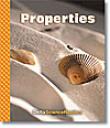Introduction and Summary:
Properties by DeltaScienceReaders is a beginning reader book that is set up in the style of a textbook but in a much small version. The first page is the table of contents and asks the student to “Think about…” and then list out: matter, properties, solid, liquid, gas. There is also a section on “People in science”. This section talks about geologists and explains what a geologist does. I liked this because the geologist pictured is a woman and in science there are few female scientists shown in books. The book explains everything in kid language and has a lot of great pictures. When discussing properties, there is a page that asks the student to identify on the page what objects are soft and what objects are hard? A teacher could take similar pictures and create a worksheet with matching. The book goes on to explain magnets and then asks the student which of the photographs would a magnet attract. When explaining liquids, solids and gases, the book explains that
“All liquids flow. Some liquids are easy to pour. Some are hard to pour. Some things float on liquids. Some things sink in liquids.” I like how the book puts keywords and terms in bold and at the end of the book there is a glossary of terms.
Curriculum Connections:
This book covers K.3 a and b, K.4 a,b, c, d and K.5a and c. The introduces magnets and magnetism(K.3a andb). This book would be great at the end or beginning of the unit on magnets. The book also introduces comparisons of color, shapes, textures, sizes and weight. (K.4a-d). The book explains the phases that water goes through and introduces the concept that some things float and some things sink.
Additional Resources:
Ms. Lee’s Kindergarten Experiments with Science is a great website for teaching Liquids and Solids to young students. The site has what experiments she conducted in her class and how to do them. It also has pictures of the kids doing the experiments.
Classified! is an experiment found on The Franklin Institute website. It is a step by step on how to conduct an experiment in classifying objects such as buttons, leaves and peanuts in their shells. It suggests using peanuts but because of allergies, teachers may have to find some other object to classify.
Changing State is an interactive activity on changing liquids to solids and gas. It is something that a student could see on a projection screen and it asks questions at each step. It would be too hard for some younger students to read on their own but they would be able to tell what everything is by the pictures.
Blue Goo is an experiment on the National Geographic website using water, cornstarch and blue food coloring. It explains the experiments and even prompts teachers to ask about before and after doing the experiment.
General Information:
Book: Properties
Author: DeltaScienceReaders
Publisher: Delta Education
Publication Date: 2003
Pages:16
Grade Range:Kindergarten through 1st grade
ISBN: 1-59242-251-9

